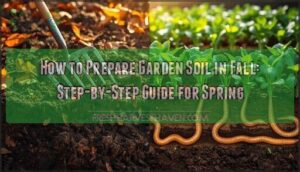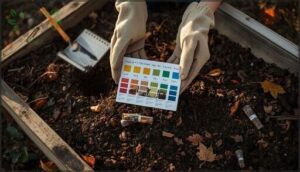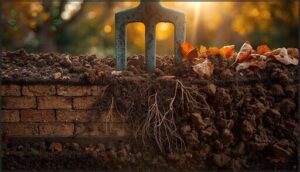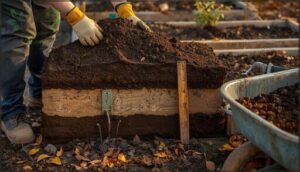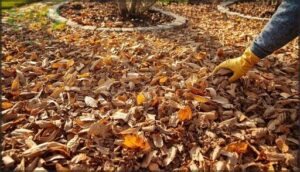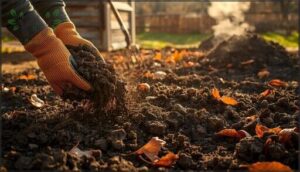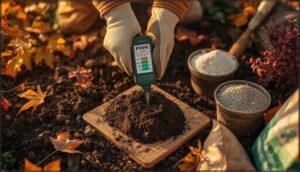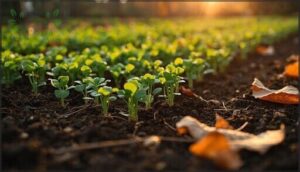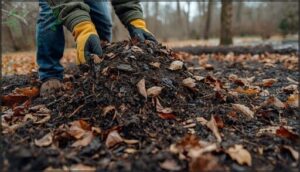This site is supported by our readers. We may earn a commission, at no cost to you, if you purchase through links.
Most gardeners wait until spring to think about their soil, then wonder why their plants struggle. The truth is that fall preparation gives you a four to six-month head start on building the rich, fertile ground your vegetables need.
While you’re raking leaves and pulling out tired tomato vines, the real magic happens underground. Microorganisms break down organic matter, amendments settle into the soil structure, and nutrients become available right when spring seedlings need them most.
Taking time now for fall garden soil preparation means you won’t be racing against the clock when warm weather arrives. You’ll walk into your garden with loose, ready-to-plant beds instead of hard, depleted ground that needs weeks of work before you can put a single seed down.
Table Of Contents
- Key Takeaways
- Why Prepare Your Garden Soil in Fall
- Test Your Soil Before Making Changes
- Clear and Clean Your Garden Beds
- Loosen Compacted Soil Without Over-Tilling
- Add Organic Matter and Compost
- Adjust Your Soil PH Levels
- Plant Cover Crops for Winter Protection
- Apply Mulch to Protect Bare Soil
- Prepare Your Garden Tools for Spring
- Frequently Asked Questions (FAQs)
- How do I prepare my soil for a fall vegetable garden?
- How do I enrich my garden soil in the fall?
- Should I fertilize my garden soil in the fall?
- How to prep garden beds in fall?
- How to prepare soil for a fall garden?
- When should I start preparing my garden for fall?
- How do you prepare soil for autumn?
- How to prepare your garden for the fall?
- When is the best time to prepare soil for a garden?
- What is fall garden prep?
- Conclusion
Key Takeaways
- Fall soil preparation gives you a four to six-month head start because organic matter breaks down and nutrients become available right when spring seedlings need them, letting you plant one to two weeks earlier than gardeners who wait.
- Testing your soil in late autumn (after harvest but before spring) reveals exactly what amendments you need—aim for a pH between 6.2 and 6.8 and apply lime or sulfur now so it has months to work into the soil structure.
- Adding two to four inches of compost and planting cover crops like cereal rye or crimson clover protects bare soil from erosion while building structure through root channels and fixing nitrogen for next season’s vegetables.
- Clearing debris, pulling weeds before they seed, and applying mulch in fall eliminates overwintering pests and diseases while preventing up to 90% of soil loss from winter runoff and freeze-thaw damage.
Why Prepare Your Garden Soil in Fall
Fall might seem like the end of the gardening season, but it’s actually one of the best times to set yourself up for success next spring. When you prepare your soil now, you give organic matter months to break down and nutrients time to settle in where plants need them most.
Here’s why working your garden beds this season makes such a difference.
Benefits of Fall Soil Preparation
When you invest time in fall garden preparation, you set yourself up for a smoother spring. Adding organic matter now boosts soil fertility and nutrient availability before planting season arrives. Fall gardening tasks like preparing soil for spring also deliver erosion control and spring workload reduction.
Loosening the soil in the fall is key because it gets the garden ready for successful spring planting. Over time, these steps support long-term health, turning your garden into a thriving, resilient system that rewards your effort year after year.
How Fall Preparation Improves Spring Planting
Fall garden preparation sets the stage for earlier spring planting—often 1 to 2 weeks sooner—because you won’t wait for saturated soil to dry. Preparing soil for spring now improves seedbed conditions through natural freeze-thaw cycles that break up clods.
Adding organic matter boosts nutrient availability, while cover crops and mulch deliver weed suppression and soil resilience, giving your spring crops a head start. Testing now can help identify potential nutrient deficiencies.
Winter Decomposition and Nutrient Release
Your fall soil preparation doesn’t pause when temperatures drop. Winter decomposition rates slow but don’t stop—around 20% of autumn leaves and organic matter break down between fall and spring through freeze-thaw cycles.
Microbial activity persists in unfrozen pockets, gradually releasing nutrients from compost and residue breakdown.
Mulching effects extend this process by stabilizing soil temperature and moisture, keeping nutrient recycling active even when the garden looks dormant.
Test Your Soil Before Making Changes
You can’t fix what you don’t understand, and that’s where soil testing comes in. A simple test tells you exactly what your soil needs—no guessing, no wasting money on amendments you don’t need.
Here’s how to get accurate results that will guide your fall prep.
When to Conduct a Soil Test
The best window for soil testing is after harvest or before spring fertilization. Testing in late autumn gives you results while labs aren’t swamped with spring requests—you’ll usually get your report within seven to ten days.
Most vegetable gardens benefit from testing every one to two years because frequent cropping quickly shifts nutrient levels. Test early enough to allow two to three months for amendments like lime to work before planting.
How to Collect Soil Samples
Where should you push your trowel to get a sample that truly reflects your soil? Proper soil testing procedures start with smart collection.
Gather 10 to 15 composite cores across your garden using these soil testing methods:
- Sampling depth: Dig each core to 6 inches for most vegetables and flowers.
- Tool cleanliness: Wash your spade or probe between areas to avoid contamination.
- Sampling patterns: Space cores randomly throughout each bed for accuracy.
Understanding Your Soil Test Results
Your soil test report might look like a chemistry quiz at first glance, but it’s easier to decode than you think. Start by checking pH levels—most vegetables thrive between 6.2 and 6.8.
Next, review nutrient levels for phosphorus and potassium, which appear with ratings like “low,” “medium,” or “optimum.” Organic matter percentages above 3% indicate healthy soil.
CEC values show your soil’s nutrient-holding capacity.
Clear and Clean Your Garden Beds
Before you start adding amendments or mulch, you need a clean slate to work with. Clearing out old plants, pulling lingering weeds, and harvesting any late-season crops will give you a fresh bed ready for improvement.
Think of it as tidying up so your soil prep has an impact come spring.
Remove Spent Plants and Debris
Once the growing season winds down, clearing old plants and debris is your first line of defense for disease reduction and insect management. Extension guides show that removing diseased foliage cuts pathogen populations before winter, while destroying crop residues eliminates hiding spots for overwintering pests.
Pull entire plants—roots and all— to prevent volunteer control issues. Compost only healthy material; bury or discard anything diseased away from your garden beds.
Pull Weeds Before They Go to Seed
One flowering weed can drop thousands of seeds—purslane sheds 200,000, while common lambsquarters releases 57,000. Timing removal matters: pull weeds the moment flowers appear to stop seed production before it begins.
Studies show that preventing seed set over just three to five years slashes future weed pressure by 80 percent, turning autumn leaves and soil preparation into your best long-term weed control strategy for the garden.
Pulling weeds before they seed for three to five years can reduce future weed pressure by 80 percent
Harvest Any Remaining Crops
Leaving crops until freezing temperatures hit can cost you most of your harvest. Warm-season vegetables like tomatoes and peppers must come out before the first killing frost—usually one to two weeks after light frosts begin in most regions—while frost-tolerant crops such as kale and Brussels sprouts can wait.
- Harvest tomatoes mature-green to ripen indoors if frost threatens unexpectedly
- Pull all remaining summer squash, peppers, and beans before hard freeze arrives
- Leave carrots and beets in soil until temperatures drop near freezing for sweeter flavor
- Remove overripe or damaged fruit immediately—they harbor disease inoculum and attract pests
- Store winter squash for three to six months at room temperature after harvesting
Timing harvest correctly protects both yield and food safety. Studies on processing tomatoes show that delaying harvest just three days past peak maturity reduces marketable yield while increasing mold incidence. Root vegetables tolerate cold better, but repeated freeze-thaw cycles damage tissue and reduce storage life.
Unharvested produce creates problems beyond lost food. Old fruits and plant debris shelter slugs, snails, and insect larvae over winter, increasing pest pressure next spring. Fall removal of rotting vegetables eliminates overwintering disease pathogens and reduces the need for chemical controls during the next growing season.
Follow proper food safety when harvesting late-season crops. Use only food-grade containers, wash hands before picking, and avoid harvesting anything that’s touched the ground. Don’t wash produce until you’re ready to use it—excess moisture promotes microbial growth and shortens storage life. Store tomatoes at room temperature away from chemicals, and keep all harvested vegetables separate from raw meats.
Storage methods vary by crop type. Butternut and other hard-shelled squash keep for months in cool, dry conditions. Brussels sprouts left on the stalk and stored near 32°F remain fresh for six weeks. Cabbage holds at least one month at high humidity, while cauliflower lasts three weeks when kept properly chilled. Never store brassicas with apples or other ethylene-producing fruits—the gas causes yellowing and ruins quality.
Clean harvest completes your fall soil preparation by removing pest habitat and disease sources. This sanitation step sets up healthier garden beds for spring planting while maximizing the value of your current season’s work.
Loosen Compacted Soil Without Over-Tilling
Compacted soil is like a locked door for plant roots—they can’t get through to find water and nutrients. Fall is your chance to open things up without making things worse.
Let’s look at how to loosen your soil the right way, so you’re not just moving dirt around.
When to Till and When to Avoid It
Tilling the soil isn’t always necessary—and sometimes it causes more harm than good. Till only when your soil is moist but crumbles in your hand, never when it’s wet or saturated. Preparing garden soil this way prevents compaction and keeps structure intact. Manual tilling or machine tilling works best for incorporating 4–5 inches of compost into new beds, but existing gardens often need less disturbance.
| When Tilling Benefits Your Garden | Over-Tilling Risks to Avoid |
|---|---|
| Breaking up surface compaction from foot traffic | Destroying soil aggregates and natural pores |
| Mixing compost uniformly into top 6–8 inches | Accelerating organic matter breakdown |
| Shifting from conventional to reduced-till systems | Creating a compaction–tillage spiral |
| Limited zones with severe erosion vulnerability | Exposing soil to wind and water erosion |
| Strategic timing when soil structure needs reset | Disrupting beneficial microbial communities |
Reduced-till evidence shows that leaving residues on the surface maintains structure better than repeated passes. Avoiding tillage when soil is saturated protects your garden for years to come. Ideal tilling means knowing when to step back and let nature do the work.
Using a Broadfork for Gentle Aeration
A broadfork offers a smarter alternative—deep aeration without the disruption. This tool reduces soil compaction by 10–15% in the top 8–10 inches, improving water infiltration and creating pathways for roots and oxygen.
Unlike rotary tilling, broadforking preserves soil biology, protecting earthworms and mycorrhizal networks while loosening dense clay.
It’s ergonomic, too: you step on the tines and rock back gently, letting leverage do the work. Perfect for no-till systems preparing garden soil with care.
Working Soil to Proper Depth
How deep should you work your soil in fall? Aim for 6–8 inches—enough to match the root depth alignment of most vegetables without triggering compaction layer avoidance issues below. This tillage depth impact allows proper amendment incorporation depth while preserving soil structure underneath.
Deeper than 10 inches risks forming a hardpan just beneath your worked zone, hurting crop performance tillage and garden preparation for spring. Match depth to your plants’ needs, not deeper.
Add Organic Matter and Compost
Adding organic matter is the single best investment you can make in your garden soil. Fall gives compost, leaves, and other amendments months to break down and release nutrients before spring planting begins.
Here’s how to choose and apply the right materials for your beds.
How Much Compost to Add
The right amount of compost makes all the difference in your garden soil. Too much can trigger over-application risks like phosphorus buildup, while too little won’t improve structure.
Annual compost calculation depends on whether you’re starting fresh or maintaining existing beds:
- New beds: Add 3–4 inches of compost, then incorporate it into the top 8–12 inches of soil (roughly 25–50% by volume percentage).
- Existing beds: Apply just 0.25–1 inch per year as maintenance—about 2–8 cubic feet per 100 square feet.
- Timing frequency: Fall or spring works well, but once yearly is enough when amending garden soil regularly.
- Avoid excess: More than 1 inch annually can cause nutrient imbalances and salt buildup in your organic matter.
- Check first: Soil testing before adding amendments ensures you’re improving fertility without overdoing it.
Using Shredded Leaves and Wood Chips
Shredded leaves and wood chips are free soil boosters you can gather right now. Apply shredded leaves 2–3 inches deep as sustainable mulching to improve soil moisture and speed up decomposition rates.
Wood chips work well for pathways and around perennials at 2–4 inches, supporting nitrogen dynamics and pest control while autumn leaves break down into nutrient-rich leaf mold by spring without robbing your plants.
Incorporating Aged Manure Safely
When used correctly, aged manure enriches garden soil with nitrogen and organic matter your plants will love. Apply 10–20 pounds of composted manure per 100 square feet in fall, incorporating it thoroughly and allowing 120 days before planting root crops or leafy greens.
This preharvest interval reduces pathogen risks, while proper composting at 131–160°F eliminates harmful bacteria and promotes environmental safeguards against contamination.
Adjust Your Soil PH Levels
Your soil’s pH controls how well your plants can access the nutrients you’ve just added. Most vegetables thrive when the pH sits between 6.2 and 6.8, but your soil test will tell you where you stand right now.
Here’s how to adjust it before spring arrives.
Optimal PH Range for Vegetables
Most vegetables thrive when soil pH falls between 6.0 and 7.0, with 6.5 being the sweet spot for your garden. At this range, nutrient availability to plants peaks—nitrogen, phosphorus, and potassium are absorbed efficiently.
Soil tests reveal whether you need to amend your soil, because suboptimal pH effects include stunted growth and poor yields. Crop-specific needs vary slightly, but managing soil pH within this window ensures healthy harvests.
Adding Lime to Raise PH
When your soil test shows a pH below 6.0, you’ll need to add lime to raise it. Managing soil pH with lime takes months, so fall application allows freeze-thaw cycles to begin the work before spring planting.
- Choose calcitic lime for calcium alone or dolomitic if your soil test also shows low magnesium
- Apply no more than 100 pounds per 1,000 square feet at once to avoid overliming risks, especially on sandy soils
- Retest soil every 3–4 years to track pH changes and amend your soil accurately
Using Sulfur to Lower PH
When your soil test reveals a pH above 6.8, sulfur application is your go-to soil amendment for acidification. Elemental sulfur works gradually—taking 3 to 18 months—because soil microbes must convert it to sulfuric acid. Apply it in fall when microbial activity is still strong, then water thoroughly to speed the process. pH monitoring every few months helps you track progress and avoid over-correction.
Nutrient availability improves as pH drops below 7.0, unlocking iron, manganese, and zinc for your plants.
| Sulfur Type | Speed of Action | Best For |
|---|---|---|
| Elemental sulfur | Slow (3–18 months) | Long-term pH control |
| Ferrous sulfate | Moderate (weeks) | Quick but temporary fixes |
| Aluminum sulfate | Fast (days to weeks) | Emergency adjustments only |
| Fine sulfur powder | Faster than coarse | Gardens needing quicker results |
| Sulfur-coated urea | Gradual release | Fertilizing while acidifying |
Plant Cover Crops for Winter Protection
Planting cover crops in fall is one of the smartest moves you can make for your garden’s long-term health. These living blankets protect your soil through winter while building its structure from the inside out.
Let’s look at which cover crops work best, how they transform your soil, and when to plant and cut them down.
Best Cover Crops for Fall Planting
The right cover crop can be your soil’s best friend through winter. Your choice depends on when you’ll plant and what you want your soil to gain.
- Cereal rye and winter rye establish quickly in fall, tolerate harsh freezes, and produce heavy biomass for spring mulch
- Legume covers like hairy vetch and crimson clover fix nitrogen while overwintering reliably in most temperate gardens
- Quick-growing buckwheat and oats fit tight planting windows and suppress weeds before cold arrives
- Winter-kill options like field peas die naturally, making spring prep easier without vigorous regrowth
How Cover Crops Improve Soil Structure
Think of cover crops as living soil architects that rebuild structure from the inside out. Their dense root networks create channels that boost water infiltration and reduce compaction down to 20–30 cm. Microbial activity thrives on root residues, binding particles into stable aggregates that resist erosion. Mixtures outperform single species, increasing aggregate stability by 16% while enhancing carbon sequestration deep in your soil profile.
| Soil Structure Benefit | Measurable Improvement |
|---|---|
| Aggregate stability | 10–19% increase in water-stable aggregates |
| Compaction reduction | Soil penetration below 2 MPa threshold at 20–30 cm |
| Water infiltration | Higher infiltration rates and moisture retention |
| Microbial activity | Elevated microbial biomass carbon and nitrogen |
When to Plant and Terminate Cover Crops
Timing makes or breaks your cover crop strategy. In zones 6–7, plant most cool-season species between mid-August and early October—cereal rye tolerates late plantings into December, but crimson clover needs 30–40 days before frost.
Terminate two to four weeks before spring planting. Later termination near flowering boosts nutrient yields—clover can deliver 135 pounds of nitrogen per acre—but earlier cutoff improves soil warming for timely vegetable starts.
Apply Mulch to Protect Bare Soil
Once your garden beds are cleared and amended, don’t leave them exposed to harsh winter weather. A protective layer of mulch acts like a blanket, shielding your soil from erosion and temperature swings while it rests.
Let’s look at how to choose and apply mulch effectively for the cold months ahead.
Choosing The Right Mulch Materials
Your mulch choice shapes how well your beds weather winter. Organic materials like wood chips, straw, and shredded leaves win out—they feed your soil as they break down while holding moisture and blocking weeds.
Wood chips suppress weeds by more than 75% at four-inch depth and decompose slowly. Inorganic options like gravel last longer but don’t build soil organic matter or nourish beneficial microorganisms.
Proper Mulch Depth for Winter
Once you’ve chosen your mulching material, apply two to four inches for most garden beds—that’s the sweet spot for winter frost protection. Layer four to six inches in colder climates to prevent freeze-thaw damage to roots.
Perennials and shrubs handle deeper winterizing, while vegetable beds need just two to three inches. Avoid piling mulch against stems—excessive depth risks rot and attracts rodents.
How Mulch Prevents Erosion and Runoff
Beyond insulation, your mulch layer shields soil from harsh weather. When heavy rains hit bare ground, water rushes across the surface, carrying topsoil and nutrients with it. A protective blanket intercepts raindrops before they dislodge particles, allowing moisture to soak in gradually instead.
Studies show mulched plots reduce runoff by up to 83% and slash soil loss by over 90% compared to exposed beds.
Prepare Your Garden Tools for Spring
Your garden soil isn’t the only thing that needs attention this fall. Taking care of your tools now means you’ll be ready to work the moment spring arrives.
Let’s look at three simple steps to prep your equipment for the season ahead.
Clean and Sharpen Garden Forks and Spades
A dirty shovel can spread disease from bed to bed just as surely as a rusty blade wastes your effort. Before you store garden tools for winter, scrub off caked soil with a stiff brush and remove rust with steel wool or a vinegar soak.
Disinfect blades with 70% rubbing alcohol to kill lingering pathogens. Then sharpen spades and forks at a 45° angle using a metal file, finishing with linseed oil on steel and grips for rust prevention.
Store Tools Properly Over Winter
Once your garden tools are clean and sharp, indoor conditions matter just as much as the work you’ve already done. Keep rust prevention front and center by housing tools in a dry garage or shed where humidity stays below 50%. Environmental control and smart tool organization extend the life of everything from hand forks to power equipment.
Winterizing garden practices that protect your investment:
- Hang tools on racks to lift metal off damp floors and prevent warping of wooden grips.
- Oil metal surfaces lightly before storage to block moisture and oxygen contact.
- Remove fuel or batteries from power equipment to avoid corrosion over winter.
- Use silica gel packs in toolboxes to absorb trapped humidity.
- Cover outdoor machines with waterproof fabric to shield them from snow and rain.
Inventory Amendments and Supplies Needed
A soil test runs USD 15–30 and tells you exactly which amendments to buy. Stock lime or sulfur for pH shifts—five pounds of lime covers one hundred square feet.
Plan storage space for bulk compost or bagged organic amendments now, before spring shortages hit. Check local supplier options, compare bulk versus bagged costs, and consider shared resource planning if you garden with neighbors.
Frequently Asked Questions (FAQs)
How do I prepare my soil for a fall vegetable garden?
Test your soil first, then clear debris and weeds.
Amend the soil with 2–4 inches of compost tilled in, ensuring proper pH for vegetable gardens and addressing any nutrient gaps before planting.
How do I enrich my garden soil in the fall?
Give your beds a nutrient “raise” by layering 1–2 inches of compost into the top 6–8 inches this fall.
Organic matter—like leaf mulch, aged manure, and worm castings—fuels soil enrichment and improves soil health naturally.
Should I fertilize my garden soil in the fall?
Yes, you should fertilize in fall. Phosphorus and potassium applied in fall bind to soil particles and remain available for spring. Organic amendments like compost decompose over winter, releasing nutrients gradually for next season’s crops.
How to prep garden beds in fall?
Nothing transforms garden beds faster than clearing debris, loosening fall tillage layers, and blending in rich organic matter—then mulching soil before winter arrives.
This readies your beds for spring success while protecting garden soil now.
How to prepare soil for a fall garden?
Start preparing garden soil in fall by clearing debris, loosening compacted areas gently, and enriching beds with 2–4 inches of compost.
Plant cover crops like winter rye to protect and build soil over winter.
When should I start preparing my garden for fall?
You should begin in late August or early September, after your summer harvest wraps up but while soil temperature stays above 50°F and conditions remain workable before the first frost date arrives.
How do you prepare soil for autumn?
Autumn soil prep starts with clearing spent plants and debris, loosening compacted areas, then adding organic matter like compost or shredded leaves.
Test soil pH, plant cover crops, and apply mulch for winter soil health.
How to prepare your garden for the fall?
An ounce of prevention is worth a pound of cure. Start with soil amendment timing—test your soil, then add organic matter like compost.
Clear debris, plant cover crops, and apply mulch for winter garden planning success.
When is the best time to prepare soil for a garden?
The ideal preparation window is late summer through mid-fall, roughly four to six months before planting season.
Fall timing lets amendments work into garden soil over winter, and soil tests reveal what your beds need by spring.
What is fall garden prep?
Fall garden prep means getting your soil ready for winter dormancy by adding organic matter, testing nutrient levels, and protecting beds—so next spring, your garden soil starts strong with improved soil health.
Conclusion
Your garden beds won’t build themselves while you wait for warmer days. Fall garden soil preparation turns those quiet months into your most productive season underground, where roots will eventually reach.
The work you do now—testing, amending, covering—creates the foundation spring plants depend on. When other gardeners are still breaking up clods and mixing in compost, you’ll be planting into soil that’s been ready since the first frost fell.
- https://hort.extension.wisc.edu/2025/08/19/soil-testing-for-successful-gardens/
- https://extension.umd.edu/resource/organic-matter-and-soil-amendments
- https://soil.copernicus.org/articles/10/139/2024/
- https://gardening.usask.ca/articles-and-lists/articles-how-to/no-till-vegetable-gardening-for-home-gardens.php
- https://www.gardeningknowhow.com/garden-how-to/soil-fertilizers/fall-soil-tasks-you-need-to-do-now

